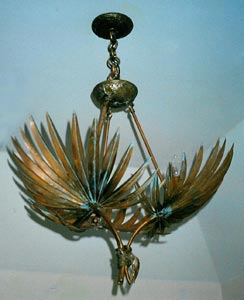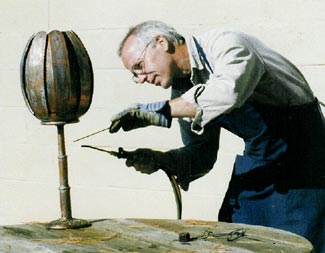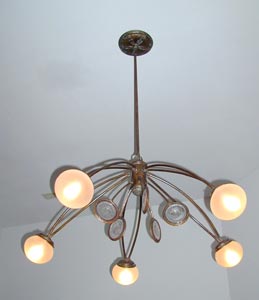The Lee Robertson Method of Copper Arts
 Copper Chandelier created using the Roberson Method, by artist Joe Cooper
Copper Chandelier created using the Roberson Method, by artist Joe CooperPhotograph by Joe Cooper
Tucked between the towns of Reed Spring and Galena, Missouri, is the geodesic domed home and workshop of Lee Robertson, a well known copper artist, oil painter and poet, whose copper method has inspired a mélange of other copper artists, and whose name is firmly entrenched in the copper world.
Robertson's artistic journey began when he returned home from Vietnam, where he was Medevac, to Carswell Air Force Base, in Fort Worth, Texas. At that time he desired to be at the end of a road in the middle of nowhere, like other brave men and women who returned home from Vietnam. Robertson's prime interest has always been Paramahansa Yogananda, a meditative practice he studied at age of 13, which continues to influence and inspire him today.
"I attended North Texas State University and was a double major in mathematics and German, but also took an art class," he says. "I was once in the art building and spotted a room filled with welding equipment. The room always seemed to be empty. At that time I wanted to do something nice for my mother for Christmas. It was December 1967---six months after returning from Vietnam. One day when she was shopping at a few galleries and shops in Dallas, Texas, she had spotted a sculpture of a metal tree on a rock. I found it interesting because it had a nice Asian look to it and I had spent a lot of time in Asia. But, even then I thought that it didn't have any soul. I knew I could create one that was more poetic, expressive and nicer. I asked the sculpture professor if I could use the equipment in the welding room when no one was there, and he said, 'sure'. I crafted the small metal tree, and my mother loved it. I combed the forests searching for interesting rocks that had poetry in them because as a poet I saw the element that I could create. Every rock is different and I considered them like a diamond in the right setting. I realized that I enjoyed creating it, so I kept making them. One of the instructors suggested that I could sell them. A light came on in my mind, because I never considered making a living from my art. A fellow artist encouraged me to share a booth with him at a show/street fair in Texas, so I schlepped my work there and everything sold out."
The rest, according to Robertson, is history. He realized he could live anywhere in the world, and saw it as an ideal opportunity to live in remote places and create. He purchased a huge stack of catalogues that dealt in rural properties and found his home, which he considers his personal domain, on 160 acres. He's resided there for 37 years.
 Copper Artist Joe Cooper
Copper Artist Joe CooperPhotograph by Sara Pitzer
"I began working in copper, which is a miraculous metal," he says. "I purchase my sheet goods from Rose Metal Products, in Springfield, MO, and my copper foil from E. Jordan Brooks Company, in Los Angeles. I use the Boss Copper Technique, which I invented. Other copper artists also do wonderful and interesting work with Boss Copper. It's part of the silver solder family of alloys; mostly silver with a little copper and phosphorus in it that grades down with the amount of copper. Then, you have 0% Boss Copper, which translates to no silver and that's the copper material that I use. My technique delves into the way things are put together. Copper will do anything and will be whatever you want it to be. Boss Copper is a perfect blend of technical potential with a large variety of materials available. There are sheet goods, oil, wire, bars of copper, tubes and all of these products are available in any wake or size. There's hard and soft copper, thick and thin copper, copper plate - it's just the basic palette of materials that make it so unlimited and extraordinary because copper is such an industrial wonderment, and is the same family of metals as platinum, gold and silver."
Robertson states that if people look at the periodic table, where the numbers are over each other, they'll find that copper has always been one of the first metals used by man, if not the first after gold. Bronze is copper and typically tin, brass is copper and zinc; it has evolved right along with mankind. With all the above industrial products available, and when the acetylene welding torch came into existence, it brought in a new spectrum of metals with copper reigning high among them.
"Copper was soldered and braised together by taking brass, silver or lead shavings and feeding it by heating the copper over charcoal with a flexing agent to oxidize," he continues. "Copper has such conductivity it would draw in whatever the thing was. Even as in my trees, and having copper around, I began making unique items, and it was then that I discovered the Boss Copper---it was a match made in heaven with the acetylene torch. I've constructed thousands of fountains that are all over the place, including one that had various wheels, kind of like Rube Goldberg's exotic things. I'd make these fountains and think what crazy thing I could do next---like dip backwards, frontward or make it flop over something else. Some were hanging fountains. I've also made some of the most beautiful table lamps that I've ever seen---they're one of a kind. I don't like to walk in my own tracks. The French Quarter, in New Orleans, has been a mainstay of my existence for the past twenty years and I've been in two galleries down there. I have copper work at Southern Expressions, on Jackson Square, and oil paintings at Bijou Nola, on St. Peter's Street. Copper has been very good to me. Some of my favorite copper pieces are my wall hangings. For me, it was never about making a living, although I had to, but I wanted to make a living doing what I could stand to do. I love being out of the woods and being left alone and copper has made that possible."
These days, Robertson creates realistic oil paintings, and taps into his creative side through his poetry. He has two fascinating poetry books out, "Field Guide to Reality and Other Poems" and "Mind Like a Mirror". Although he currently shifted away from his original copper roots, he continues to be inspired by the evolving legacy of copper as a medium.
 Flower Copper Chandelier by Joe Cooper
Flower Copper Chandelier by Joe CooperPhotograph by Joe Cooper
"Copper is never going away, people don't throw copper out," he expands. "The copper that I use in my work could have been a piece of electrical wire in an industrial building five years ago. Fifty years ago it could have been an industrial fitting in a large boiler factory. For me, Copper has reincarnation. It's always changing. The copper that people were using in the 1700s and 1800s is still used today, but the form is unrecognizable. I've tried to create everything I've made with enduring aesthetic appeal that would stand on its own and would be so beautiful that no one would ever throw it away. I might go back to my roots and do trees again, which will be beautiful, but I've never taken them as far as I knew I could go with them. I don't consider myself a philosopher, but court jester to the universe!"
Robertson has mentored many copper artists, who hold him in the highest esteem. They have worked with Robertson and currently carry on his technique and unique adaptations of his methods. They all consider Robertson the 'master of copper'.
"When teaching students I always tell them that there's only fifteen minutes of instruction and the rest is doing it," he explains. "Also, you can spend the rest of your life exploring what you've learned in that fifteen minutes because it's exhaustible and the only limitation is your imagination. I feel such gratitude to be able to put this in the hands of so many talented people."
Joe Cooper, from the J.T. Cooper Studio in Tryon, North Carolina, apprenticed with Robertson in 1983, learning Robertson's unique approach to copper.
"He developed an approach to working with copper that goes in a multitude of directions, and he produced examples in all of these," says Cooper. "He has done bas relief panels, full scale sculpture, copper fountains and plant stands, lighting fixtures, mobiles, architectural scale signage, vessels and a variety of objects used in the home such as dust pans, cups and candle sticks. His methodology is very innovative as well as his artistic expression, which he shared along with his focus, productivity and intensity. I feel wonderful and privileged that I had a chance to apprentice with him. He's a great teacher, and a good man."
Cooper had been searching for Robertson a few years before he found him. He had viewed his work earlier and felt that Robertson's work, the body of knowledge behind it, was amazing. Now Cooper works out of his own studio and focuses on custom lighting fixtures. His main customers are interior designers and architects who are searching for a higher level of quality, but anyone who is interested in his custom designed pieces can contact him.
 Copper Walkway Lantern by Joe Cooper
Copper Walkway Lantern by Joe CooperPhotograph by Joe Cooper
"Part of what distinguishes us on Robertson's approach is that we use roofing copper," continues Cooper. "There's usually a distributor who carries copper sheets that contractors buy to do roofs, downspouts and gutters. I purchase mine from Loxcreen Company, a wholesaler in South Carolina. Robertson's technique uses roofing copper, copper plumbing tubing and copper electrical wire, which are shaped and joined together with a copper alloy brazing rod."
Phil Herr, from Cow Creek Studio in Missouri, also learned the copper technique from Robertson, and continues this craft, as well as clay and woodworking, from his studio. Phil is known for his caricatures of Johnny Carson, which he sculpted from a five-foot log, Jack Carney, and a wolf piece for Marlin Perkins. He's also been carving the Marque Award for the Illinois Secretary of State Antique Auto Show, for the past thirty years.
"My wife and I used to live in the Ozarks and created quality handmade in America items," he recalls. "We moved back to Illinois, and I wanted to learn how to weld copper. I called Lee and he came here for two days. I not only learned his technique, but we built a fountain that weekend. Lee is a neat guy with a lot of patience for teaching. I had never welded anything before and after he showed me a couple of times, he put the torch right into my hands and said, 'now you do it'. He showed me how to make a jig to form and bend copper tubing and how to hammer out bowls, dishes and shapes. I can't say enough nice things about him, and I still, occasionally, email him and ask him questions, which he's always happy to answer. He's one of the most interesting men I've met, and a true artist as well as a poet. He's done fantastic sculptures in front of churches, like eight or nine foot religious sculptures, and all of his work is outstanding."
Also in this Issue:
- The Lee Robertson Method of Copper Arts
- Still Life on Copper: The Process of Discovery
- How a Historic Cupola Became Copper Art
- The Art of Early Copper Tools
- Cast Images: American Bronze Sculpture Highlights New York Works
